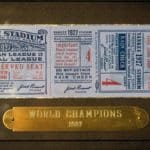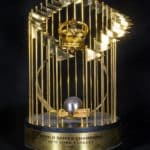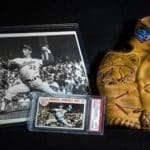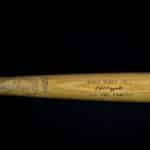History and Collectibles
By Marshall Fogel and James Dahlen
Photos by James Dahlen
At the end of the 2016 Major League Baseball season, more than 40 million people tuned in to watch the Chicago Cubs end their 108-year World Series hiatus by beating the Cleveland Indians. Since 1903, the baseball season has culminated with a best of seven series between the American League champion team and the National League champion team to determine professional baseball’s champion. Each sport has its own championship traditions, but none have roots as deep and expansive as the Major League Baseball’s Fall Classic World Series.
In 1884, almost 20 years before the first official World Series, variations of a postseason championship were held, usually called The Championship of the United States. When the Providence Greys beat the New York Metropolitan Club in 1884, newspapers called the Greys “World Champions.” As the league continued to grow in size, the name stuck. Over the next 19 years, the championship went through a series of changes. Modifications included the number of games, ranging from six to fifteen, and the way competing teams from each league would reach the championship. Financial conflict sparked between the National and American leagues during the early stages of the World Series; however, compromises were reached, and the Boston Americans and Pittsburgh Pirates competed in the first ever World Series in 1903.
Since then, the World Series has been played 112 times, with the American League winning 64 and the National League winning 48. The World Series have only been cancelled twice – due to business disagreements in 1904, and a player lockout in 1994.
Throughout the season, fan bases root for their teams to reach the Fall Classic. Some fans have gone their entire life without witnessing their team win a World Series, such as the Boston Red Sox whose championship drought lasted from 1918 to 2004, or the Chicago Cubs whose lapse covered the time between 1908 and 2016. On the other hand, some fans have seen their team win four World Series in five years, like the New York Yankees from 1995 to 2000.
Buyer Beware!
When buying sports collectibles, especially at the higher end, it is extremely important to be sure that they are authentic and original. For example, there are times when a collectible is a replacement of an original piece, such as number replacement on the back of a baseball uniform. Any changes from the original should be disclosed by the seller.
There are companies that provide letters of authenticity; however, those letters are not guarantees. In fact they are more like letters of opinion. Anyone can write a letter of authenticity. A good number of these letters are not written by experts. In the event it is later found that you purchased a collectible that was not properly represented in the authentication letter, the author is generally not required to reimburse you for your loss.
It is my opinion that any letter of opinion, as I choose to call it, should provide clear and convincing evidence that the item you are purchasing is what it purports to be. The appropriate definition for clear and convincing evidence means that the party must provide evidence that leaves you with a firm belief or conviction that it is highly probable that the factual claims are true. This definition is in part used by judges in giving jury instructions.
In the world of baseball there is probably no more enviable private collection than that owned by Marshall Fogel, an attorney from Denver, Colorado. Items from Marshall’s
collection have been on display at the Denver Art Museum, featured in the book Smithsonian Baseball, and can be found at the Yankee Museum in their new stadium in the Bronx outside of New York City. He is also the co-author along with Henry Yee of the book “Portrait of Baseball Photography.”













Related posts: